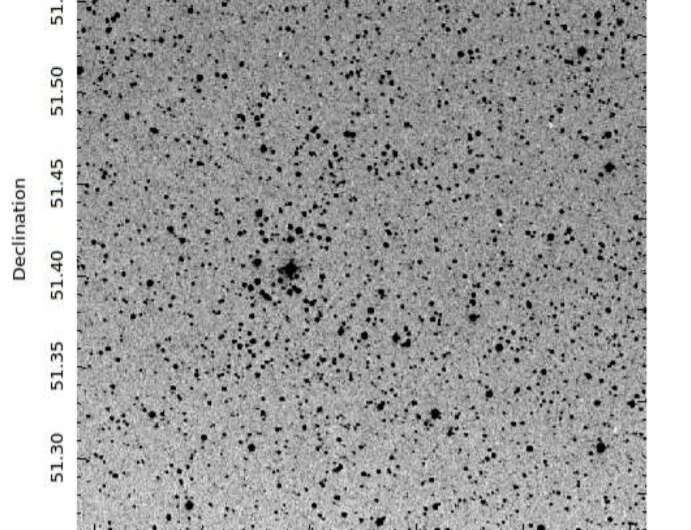The identification map of NGC 1348 taken from the DSS. Credit: Bisht et al., 2021.
By analyzing data from various astronomical surveys, astronomers have performed an exhaustive photometric and kinematical study of an open cluster known as NGC 1348. The new research, detailed in a paper published April 2 on arXiv.org, provides important information regarding the parameters of this cluster.
Open clusters (OCs), formed from the same giant molecular cloud, are groups of stars loosely gravitationally bound to each other. So far, more than 1,000 of them have been discovered in the Milky Way, and scientists are still looking for more, hoping to find a variety of these stellar groupings. Expanding the list of known galactic open clusters and studying them in detail could be crucial for improving our understanding of the formation and evolution of our galaxy.
Located some 6,000 light years away from the Earth, NGC 1348 (also known as OCL 391) is a galactic OC estimated to be at least 50 million years old. Although NGC 1348 was discovered in 1790, it remains a poorly studied cluster, as to date, only several detailed observations of this object have been conducted.
A team of astronomers led by Devendra Bisht of the University of Science and Technology of China (USTC) in Hefei, China, took a closer look at NGC 1348 in order to shed more light on its properties. For this purpose, they analyzed data from ESA's Gaia satellite, NASA's WISE spacecraft and the Pan-STARRS1 telescope. The study was complemented by datasets from the UKIRT InfraRed Deep Sky Surveys (UKIDSS) and the AAVSO Photometric All-Sky Survey (APASS).
"We extracted photometric data of the cluster within a 10 arcmin radius from the APASS, PanSTARRS1, UKIDSS and WISE along with astrometric data from GAIA EDR3. The main purpose is to take different photometric surveys' data to check the extinction law towards the open cluster NGC 1348 from the optical to the mid-infrared. After cross-matching all these catalogs, the fundamental parameters, mass function, galactic orbits and kinematics have been studied in the current paper," the researchers explained.
The team identified 438 member stars of NGC 1348 with membership probabilities higher than 50% and brighter than 20 mag. The selected sample of stars was used to derive the cluster's fundamental parameters.
The radius of NGC 1348 was calculated to be some 18.48 light years or 7.5 arcmins, while its tidal radius was estimated to be nearly 30 light years. The mean proper motions of the cluster were measured to be approximately 1.27 and −0.73 mas/year in the right ascension and declination directions, respectively.
The study found that NGC 1348 is located about 8,500 light years away, therefore farther than previously thought. The age of the cluster was estimated to be around 160 million years, what is based on comparing the color-magnitude diagram with theoretical isochrones.
Moreover, the research detected a mass segregation effect in NGC 1348 and found that the mass function slope is at a level of 1.3, in the mass range between 1.0 and 4.1 solar masses. According to the authors of the paper, the results suggest that NGC 1348 is a dynamically relaxed OC.
More information: Detailed analysis of the poorly studied northern open cluster NGC 1348 using multi-color photometry and GAIA EDR3 astrometry, arXiv:2104.01059 [astro-ph.GA] arxiv.org/abs/2104.01059
© 2021 Science X Network
























